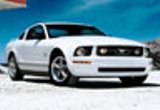Ford unveils revamped Mustang for 2010
on November 19th, 2008 at 1:03 pmDETROIT (Reuters) – Ford Motor Co unveiled a new version of its iconic Mustang sports car on Tuesday with an exterior that differs in every way from its predecessor, except for the roof panel.
Ford expects significant fuel economy improvements with the 2010 Mustang GT and improved horsepower over the current version that gets about 22 miles per gallon on the highway. But it will still be gas-thirsty.
Ford and fellow U.S. automakers General Motors Corp and Chrysler — which is owned by private equity firm Cerberus Capital Management LP — were in Washington on Tuesday to plead for a $25 billion U.S. government bailout package.
Detroit’s Big Three have suffered plunging auto sales as consumers have abandoned their bigger, gas-guzzling sports-utility vehicles, pickup trucks and minivans. The credit crunch has further hurt sales, as many consumers have found auto loans increasingly hard to obtain.
But Ford’s unveiling of the Mustang, ahead of an auto show in Los Angeles, was a sign that at least one of the three major U.S. automakers was pushing ahead with its basic program of building cars.
The new Mustang, a 2010 model year revamp from the Pony emblem on the front to sequential turn signals on the rear taillights, brings modern touches to the last major redesign that brought back familiar shapes from its 1960s origins.
“The design is very recognizable as a Mustang and yet everything is new,” said Peter Horbury, Ford’s executive director of design for the Americas.
“You ought to be able to see this car 100 yards down the road at night and know what it is,” Mustang chief designer Doug Gafka said.
Sales of the current Mustang, which can be found in various V6 and V8 coupes and convertibles, have been sagging and the new version is aimed to spark renewed interest in the muscle car. Mustang sales were down nearly 30 percent in 2008 through October at 83,557. The new version will be available in 2009.
Ford has built the Mustang continuously for 45 years and believes the new version will have notably better handling.
The No. 2 U.S. automaker also aimed for significant improvements in the interior, adding a soft instrument panel, improving the fit and finish of materials, and adding advanced electronics options.














